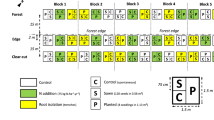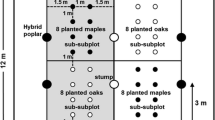Abstract
The effects of post-planting weed control intensity on the cover and composition of ground vegetation, and on growth, survival and foliar nutrient concentrations of 4-year old bare-rooted Scots pine (Pinus sylvestris L.) seedlings were studied over a 15-year period with experimentation on former arable land. Weed control treatments with terbuthylazine and glyphosate were carried out 1–3 times during successive years, either as overall or as spot applications. The vegetation cover and the shading effect of vegetation decreased with increasing weed control intensity. The more intensive the weed control was, the better was the afforestation result in terms of tree seedling growth and survival. Overall application repeated three times increased seedling survival by 79 percentage points, and their final height, breast height, diameter, and stand volume after 15 years were increased by 183, 19, 15, and 822%, respectively. Weed control did not affect the foliage nutrient concentrations, except for magnesium. However, increase in weed control intensity was reflected in larger needle size 5 years after planting.








Similar content being viewed by others
References
Davies RJ (1985) The importance of weed control and use of tree shelters for establishing broadleaved trees on grass-dominated sites in England. Forestry 58:167–180
Davies RJ (1987) Trees & weeds. Weed control for successful tree establishment. Forestry Commission. Handbook 2. HMSO Books, London, p 36. ISBN 0-11-710208-3
Falkengren-Grerup U, ten Brink J-A, Brunet J (2006) Land use effects on soil N, P, C and pH persist over 40–80 years of forest growth on agricultural soils. For Ecol Manage 225(1–3):74–81
Ferm A, Hytönen J, Lilja S, Jylhä P (1994) Effects of weed control on the early growth of Betula pendula seedlings established on an agricultural field. Scand J For Res 9:347–359
Halonen O, Tulkki H, Derome J (1983) Nutrient analysis methods. Metsäntutkimuslaitoksen tiedonantoja, 121, 28 p
Hytönen J (2009) Effect of seedling size on their long-term survival in afforestation of former agricultural land. In: Scott Bentsen N (ed.). Forest vegetation management–towards environmental sustainability. Forest & Landscape Working Papers 35:89–91
Hytönen J, Jylhä P (2005) Effects of competing vegetation and post-planting weed control on the mortality and growth of and damage caused by voles to Betula pendula when planted on former agricultural land. Silva Fenn 39(3):365–380
Hytönen J, Jylhä P (2008) Fifteen-year response of weed control intensity and seedling type on Norway spruce survival and growth on arable land. Silva Fenn 42(3):355–368
Hytönen J, Wall A (1997) Metsitettyjen turvepeltojen ja viereisten suometsien ravinnemäärät. Summary: nutrient amounts of afforested peat fields and neighbouring peatland forests. Suo-Mires Peat 48(2):33–42
Jylhä P, Hytönen J (2006) Effect of vegetation control on the survival and growth of Scots pine (Pinus sylvestris L.) and Norway spruce (Picea abies (L.) Karst) planted on former agricultural land. Can J Forest Res 36:2400–2411
Kiirikki M (1993) Seed bank and vegetation succession in abandoned fields in Karkali Nature Reserve, southern Finland. Ann Bot Fenn 30:139–152
Koerner W, Dambrine E, Dupouey JL, Benoıt M (1997) Influence of past land use on the vegetation and soils of present day forest in Vosges mountains. France J Ecol 85:351–358
Kogan M, Figueroa R, Gilabert H (2002) Weed control intensity effects on young radiata pine growth. Crop Prot 21:253–257
Laasasenaho J (1982) Taper curve and volume functions for pine, spruce and birch. Comm Inst For Fenniae 108, 74 p
Lund-Høie K (1984) Growth responses of Norway spruce (Picea abies L.) to different vegetation management programmes–preliminary results. Asp Appl Biol 5:127–133
Nordborg F, Nilsson U (2003) Growth, damage and net nitrogen uptake in Picea abies (L.) Karst. seedlings, effects of site preparation and fertilisation. Ann For Sci 60(2003):657–666
Paatela J, Erviö L-R (1971) Weed seeds in cultivated soils in Finland. Ann Agr Fenn 0:144–152
Peltola A (ed) (2008) Finnish statistical yearbook of forestry. SVT agriculture, forestry and fishery 2008. Finnish Forest Research Institute, 458 p
Plant Protection Products (2009) Evira Publications 1/2009. Finnish Food Safety Authority Evira, Division of Plant Protection Products. 109 p. + app. Available at: http://www.evira.fi/attachments/kasvintuotanto_ja_rehut/kasvinsuojeluaineet/luettelo/kasvinsuojeluaineet_2009_web.pdf
Ritter E, Vesterdal L, Gundersen P (2003) Changes in soil properties after afforestation of former intensively managed soils with oak and Norway spruce. Plant and Soil Changes in soil properties after afforestation of former intensively managed soils with oak and Norway spruce. Plant Soil 249(2):319–330
Törmälä T (1982) Structure and dynamics of reserved field ecosystem in central Finland. Biological Research Reports from the University of Jyväskylä, vol 8, 58 p
Wagner RG, Mohammed GH, Noland TL (1999) Critical period of intraspecific competition for northern conifers associated with herbaceous vegetation. Can J For Res 29:890–897
Wagner RG, Little KM, Richardson B, McNabb K (2006) The role of vegetation management for enhancing productivity of the world’s forests. Forestry 79(1):57–79
Wall A, Hytönen J (2005) Soil fertility of afforested arable land compared to continuously forested sites. Plant Soil 275(1–2):245–258
Willoughby I, Balandier P, Scott Bentsen N, McCarthy N, Claridge J (2009) Forest vegetation management in Europe. Current practice and future requirements. COST Office Brussels. 156 p
Acknowledgments
We thank Seppo Vihanta for taking part in the establishment and measurement of the experiment as well for assistance with computing work. We appreciate the help of numerous other persons in establishing and taking field measurements. A grant from Metsämiesten Säätiö made the final measurement of the experiment possible.
Author information
Authors and Affiliations
Corresponding author
Additional information
Communicated by C. Ammer.
This article originates from the final conference of the Cost action E47 “European Network for Forest Vegetation Management: Towards Environmental Sustainability” in Vejle, Denmark, 4–7 May 2009.
Rights and permissions
About this article
Cite this article
Hytönen, J., Jylhä, P. Long-term response of weed control intensity on Scots pine survival, growth and nutrition on former arable land. Eur J Forest Res 130, 91–98 (2011). https://doi.org/10.1007/s10342-010-0371-6
Received:
Revised:
Accepted:
Published:
Issue Date:
DOI: https://doi.org/10.1007/s10342-010-0371-6




